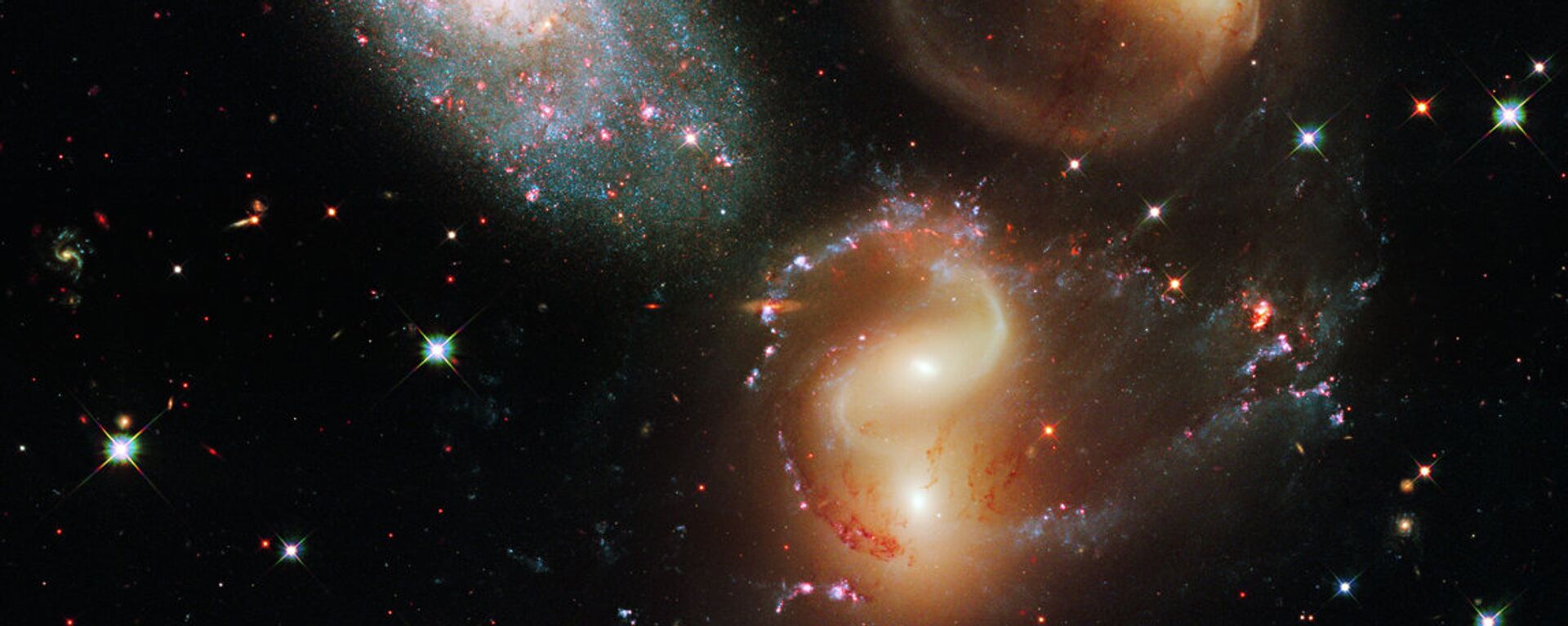https://sputnikglobe.com/20230405/webb-telescope-discovers-oldest-known-galaxies-1109182071.html
Webb Telescope Discovers Oldest Known Galaxies
Webb Telescope Discovers Oldest Known Galaxies
Sputnik International
The James Webb Space Telescope has discovered four of the most distant galaxies ever observed, one of which was formed just 320 million years after the Big Bang.
2023-04-05T23:45+0000
2023-04-05T23:45+0000
2023-04-06T00:07+0000
science & tech
james webb space telescope (jwst)
james webb space telescope
galaxies
universe
big bang
big bang
https://cdn1.img.sputnikglobe.com/img/07e7/04/05/1109181911_0:179:813:636_1920x0_80_0_0_88455bce96c63bfc317d715f2e0ca3cf.png
Using the NIRCam (Near-Infrared Camera) and NIRSpec (Near-Infrared Spectrograph) instruments that captures infrared radiation, the James Webb was able to record four of the most distant galaxies from the Milky Way that have ever been seen through the lens of Earth's telescopes. They were formed less than half a billion years after the Big Bang, while the present universe is already about 13 billion years old.The most distant of the four galaxies, called JADES-GS-z13-0, formed just 320 million years after the Big Bang. And it is the most distant cosmic object that astronomers have recorded.NIRCam is the main imaging unit of the telescope, operating in the 0.6-5 μm range (1 μm = 0.000001 m).NIRSpec allows physical properties of astronomical objects, such as mass or chemical composition, to be determined. The instrument consists of multiple cells with individual control, which allows to concentrate on specific objects, "sifting out" unnecessary radiation. NIRSpec can provide spectroscopy in the same range as NIRCam.All four galaxies are extremely low in mass, about 100 million times the mass of the Sun. By comparison, the Milky Way, according to some estimates, contains 1.5 trillion solar masses. All of the stars were formed at about the same speed as the stars in our galaxy.The findings were published in two articles in the journal Nature Astronomy.
https://sputnikglobe.com/20230111/webb-telescope-reveals-clash-of-galaxies-in-detail-1106218136.html
Sputnik International
feedback@sputniknews.com
+74956456601
MIA „Rossiya Segodnya“
2023
News
en_EN
Sputnik International
feedback@sputniknews.com
+74956456601
MIA „Rossiya Segodnya“
Sputnik International
feedback@sputniknews.com
+74956456601
MIA „Rossiya Segodnya“
james webb telescope, oldest galaxies, how old is the universe, webb discovered oldest galaxies, nircam nirspec, jades-gs-z13-0, webb telescope discoveries
james webb telescope, oldest galaxies, how old is the universe, webb discovered oldest galaxies, nircam nirspec, jades-gs-z13-0, webb telescope discoveries
Webb Telescope Discovers Oldest Known Galaxies
23:45 GMT 05.04.2023 (Updated: 00:07 GMT 06.04.2023) The James Webb Space Telescope has discovered four of the most distant galaxies ever observed, one of which was formed just 320 million years after the Big Bang.
Using the NIRCam (Near-Infrared Camera) and NIRSpec (Near-Infrared Spectrograph) instruments that captures infrared radiation, the James Webb was able to record four of the most distant galaxies from the Milky Way that have ever been seen through the lens of Earth's telescopes. They were formed less than half a billion years after the Big Bang, while the present universe is already about 13 billion years old.
The most distant of the four galaxies, called JADES-GS-z13-0, formed just 320 million years after the Big Bang. And it is the most distant cosmic object that astronomers have recorded.
NIRCam is the main imaging unit of the telescope, operating in the 0.6-5 μm range (1 μm = 0.000001 m).

11 January 2023, 10:02 GMT
NIRSpec allows physical properties of astronomical objects, such as mass or chemical composition, to be determined. The instrument consists of multiple cells with individual control, which allows to concentrate on specific objects, "sifting out" unnecessary radiation. NIRSpec can provide spectroscopy in the same range as NIRCam.
"These results are the culmination of why the NIRCam and NIRSpec teams joined together to execute this observing program," said co-author Marcia Rieke, NIRCam principal investigator from the University of Arizona.
All four galaxies are extremely low in mass, about 100 million times the mass of the Sun. By comparison, the Milky Way, according to some estimates, contains 1.5 trillion solar masses. All of the stars were formed at about the same speed as the stars in our galaxy.
"The frontier is moving almost every month," said Pieter van Dokkum, an astronomer at Yale University not involved in the research, adding that there was now "only 300 million years of unexplored history of the universe between these galaxies and the Big Bang".
The
findings were
published in two articles in the journal Nature Astronomy.


